AMD's 65nm Brisbane Core Previewed: The most energy efficient AMD CPU to date
by Anand Lal Shimpi on December 14, 2006 6:08 PM EST- Posted in
- CPUs
Gaming Performance & Power Usage
By and large the biggest contributor to power consumption when running 3D games is going to be your graphics card, and in this case it's the 8800 GTX plugged into our test bed. That being said, there is still a fairly sizable difference between the CPUs in power consumption; we're simply dealing with much higher numbers than before thanks to the GPU running at full load.
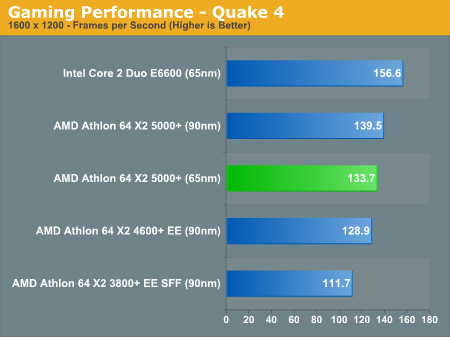
Core 2 is significantly faster than the X2 in Quake 4, which we've seen in previous comparisons. We ran into a strange anomaly with gaming performance and our Brisbane chip; for some reason, in Quake 4 and Half Life 2, the 65nm 5000+ ended up being slightly slower than its 90nm counterpart. We're still waiting for an answer from AMD, but as far as we know there shouldn't be any performance differences between the two chips.
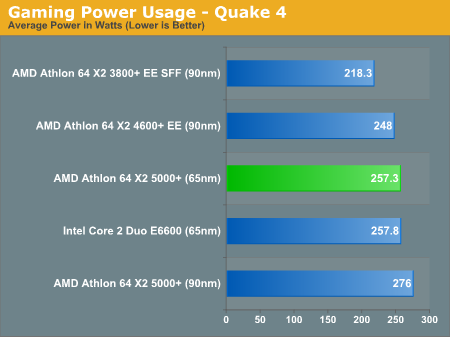
Power consumption is basically equal between the Brisbane 5000+ and the Core 2 Duo E6600, but given that the latter performs so much better Intel gets the overall win in power efficiency:

Switching games doesn't change the rankings at all, as Oblivion gives us a repeat of what we saw in Quake 4. Interestingly enough, we didn't see a performance difference between the 90nm and 65nm 5000+ offerings here like we did in Quake 4.
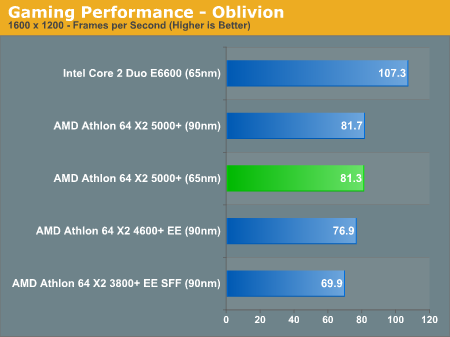
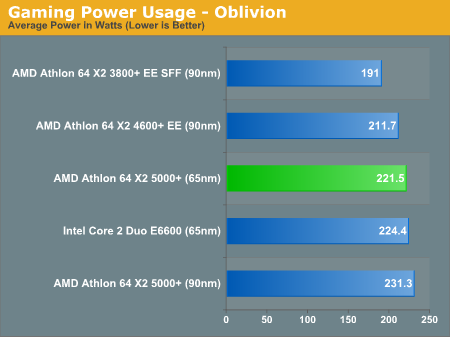
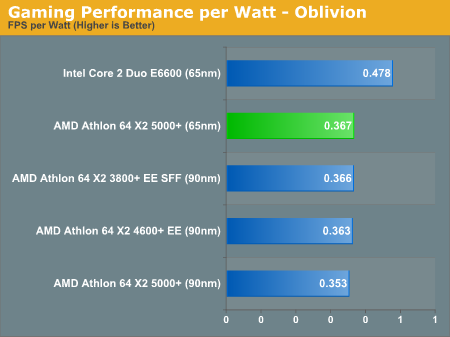










63 Comments
View All Comments
Live - Thursday, December 14, 2006 - link
It does not use more power then any other chip except the 90nm X2 5000+. Where did you get that from? Did you read the article?Stereodude - Thursday, December 14, 2006 - link
Yes, I read the article. Excluding the C2D it uses the 2nd most amount of power, basically tied with the 65W 4600+.smitty3268 - Thursday, December 14, 2006 - link
Not all the power that goes into a chip is released as heat. The heat is basically wasted power that "leaks." So if a chip can get more useful work out of the same amount of power then the amount of heat released would decrease even while power consumption remained steady.I'm not an expert, but I believe a lot of the special new process techniques we always here about (like strained silicon) basically just reduce the amount of wasted energy. Am I right here?
Stereodude - Thursday, December 14, 2006 - link
Sorry, but that's incorrect. All the power is turned into heat. The power can't be going anywhere else. Power in = Power out.It's not like a LED where you get some energy out as light, or a motor where you get mechanical energy out of it in addition to heat.
finalfan - Thursday, December 14, 2006 - link
If all the power can be turned into heat then it will be the most efficient heater the human being ever built. And even greater, you get all the computation done for free. Could you believe that?Stereodude - Thursday, December 14, 2006 - link
Where else is the energy going if it isn't getting turned into heat? You apparently don't have any idea how the transistors in a processor work.splines - Thursday, December 14, 2006 - link
You apparently don't have any idea about basic thermodynamics.If the processor released all of its energy in heat, it'd be the world's most efficient space heater.
You have forgotten a few little points, like that work is done by a processor (wouldn't be much point otherwise). Transistors are switched, mostly, however the IC itself can expand and contract, as well as the packaging material. The heat generated by a CPU is because of the resistance inherent to the circuits. All of the above is considered energy expended (or, more properly, changed in state).
In other words, don't go around insulting people's intelligence when you don't know yourself what you're on about.
Stereodude - Thursday, December 14, 2006 - link
I'm betting only one of us has an Electrical Engineering degree, and guess what... You're not the one with it.The work being done by the CPU is what makes the heat. The transistors themselves create heat because they consume power, and a lot of it, to switch from one state to another at high speeds.
I will say it again since you still don't get it, though it probably won't help. Energy is conserved. Electrical energy goes in, and heat comes out. The thermal expansion and contraction of the part isn't work. It's a side effect of the heat being product when the transistors consume electrical power by switching and make heat.
slayerized - Friday, December 15, 2006 - link
Thermodynamics 101- First law of thermodynamics: “Energy can neither be created nor destroyed, it can only be converted from one form to another” (Power --> Heat)smitty3268 - Friday, December 15, 2006 - link
I think everyone here knows that, the issue is that current -> heat is not the only type of transformation that can occur. If it was then anything electric wouldn't be able to do anything at all except create heat, and obviously that isn't true.